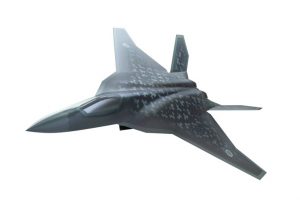Japan has not officially selected a partner for its F-X future fighter program, the Ministry of Defense’s (MoD’s) Acquisition, Technology & Logistics Agency (ATLA) told Jane’s this week. The Nikkei Asian Review earlier this month reported that Tokyo had already picked its partner for its next generation fighter aircraft.
“The Japan MoD is in discussion with the U.S. and the UK from the viewpoint of ensuring interoperability, cost effectiveness, and technical reliability. We have been exploring the possibility of co-operation with these two countries,” an ATLA spokesperson was quoted as saying by Jane’s. “There is no such fact that we have decided specific policies including partner countries.”
ATLA did confirm that it will push ahead with a totally new design for the F-X next-generation fighter jet: “Furthermore, the Japanese MoD has excluded ‘a derivative of an existing model’ as an option [for the fighter aircraft development program] and we came to the conclusion that we would develop ‘a new model.’” In 2016, Japan unveiled an experimental fifth-generation fighter technology demonstrator, dubbed X-2 “Shinshin” (formerly the ATD-X), which was intended to serve as the basis for the F-X fighter.
This January the Japanese MoD released the first “conceptual image” of the F-X fighter. The MoD intends to procure up to 100 new fifth-generation air superiority fighters by the end of the 2030s. The aircraft will replace the Japan Air-Self-Defense Force’s (JASDF’s) Mitsubishi F-2 fighter aircraft.
Japan has been looking for international partners to most likely collaborate with Mitsubishi Heavy Industries (MHI), and various Japanese subcontractors on the F-X for the past two years. To that effect, the MoD issued a number of requests for information (RFIs) to international aircraft makers in 2018 and 2019. BAE Systems, EADS, Lockheed Martin, Boeing, and Northrop Grumman reportedly responded to the request.
U.S. aircraft maker Lockheed Martin, the reported frontrunner, submitted a design proposal for a twin-engined air superiority fighter jet that combines the F-22’s airframe with the F-35’s electronic suite. Japan’s Ministry of Finance, however, dismissed the proposal as too expensive.
As I wrote last year, the U.S. government has expressed its willingness to share sensitive computer code used to operate the fifth-generation Lightning II F-35’s avionics and mission systems with Japan as part of Lockheed Martin’s pitch to co-develop the new fighter aircraft.
“In detail, the U.S. has expressed its willingness to release the software installed in the F-35 to control parts including the aircraft’s engine and the missiles,” I explained. Furthermore, I noted:
Should the Japanese government select Lockheed Martin’s design, the United States is reportedly prepared to allow the integration of Japanese-made components into the fighter jet design including a new mission system and engine, which would be a boon to Japan’s military aviation industry.
Japan has also shown interest in the BAE Systems Tempest Future Fighter Aircraft project, which aims to design and deploy a sixth-generation stealth fighter for the Royal Air Force (RAF) by 2035.
The Tempest program is headed by BAE Systems alongside project partners Italian defense contractor Leonardo for integrated sensors and electronic warfare capabilities, the European consortium MBDA for the aircraft’s weapons systems, and the UKs Rolls-Royce for the aircraft’s engine.
Japan is expected to determine a “preliminary framework” outlining its partnership strategy, both domestic and international, by December 2020.

































